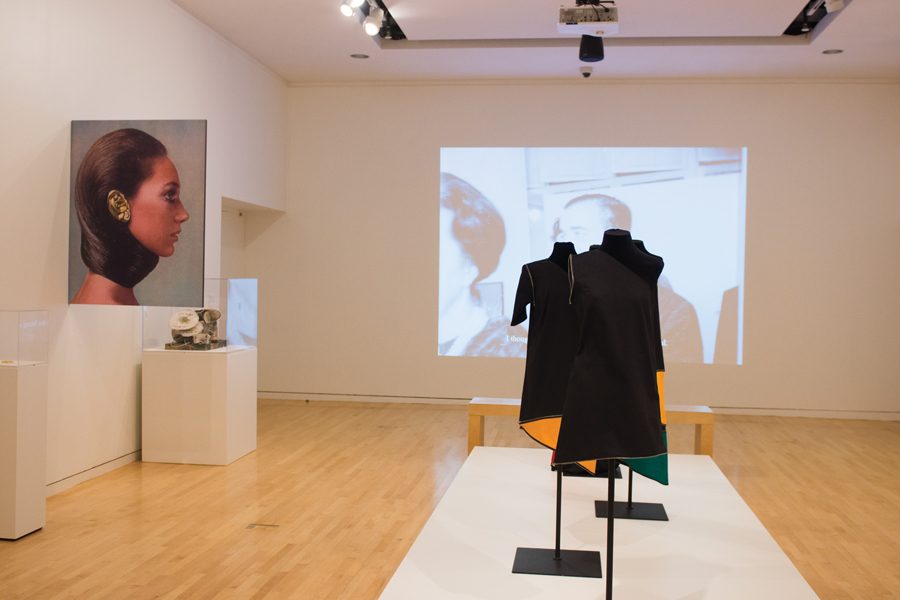“Pop América” exhibition showcases the rich tradition of Latin American pop art
Aaron Wang/The Daily Northwestern
Pieces from “Pop América.” The exhibition, which features several pop art pieces from Latinx artists, opened Sep. 21 and will close Dec. 8.
September 25, 2019
For most people, knowledge of pop art might begin and end with names like Andy Warhol and Roy Lichtenstein. But the movement included many diverse artists whose contributions to the style are often unrecognized, something the Block Museum of Art hopes to correct with its latest exhibition, “Pop América, 1965-1975.”
“Pop América” showcases pop art from the mid-1960s to mid-1970s that were created predominantly by Latinx artists in North American, South American and Caribbean countries. It opened at the Block last Saturday and will close Dec. 8. The exhibition launches the Block’s current season, which shines the spotlight on global modernist art, according to the Block’s Academic Curator Corinne Granof.
“It’s this year of looking at global modernism,” Granof said, “of rewriting this history of what we think of when we think of modernist art, and it’s not just Paris or New York, but there’s this whole broader vision of what was going on throughout the world.”
“Pop América” started as a collaboration between the Nasher Museum of Art at Duke University and the McNay Art Museum in San Antonio last year. The exhibition, which was curated by Duke professor Esther Gabara, has been presented at the Nasher and McNay museums before coming to The Block as the final stop on the exhibition’s tour.
Granof said “Pop América” aims to challenge common perceptions of pop art, both in terms of content and the artists behind the work. Although pop art started in the U.S., Latin American artists adopted the style and began interpreting it through the lens of their cultures.
She added that while pop art is sometimes regarded as light and frivolous, many works featured in the exhibition address the political and cultural climate of Latin America in the late 1960s. One of the pieces, Antonio Caro’s “Colombia Coca-Cola,” displays the name of the artist’s home country in the style of the Coca-Cola logo, raising ideas of how U.S imperialism and capitalism have changed the Latin American region.
“There’s a playful quality to a lot of the work in the exhibition,” Granof said. “But there’s also a lot of work that has this stronger political edge and are responding to economic conditions, social conditions, political conditions. So it’s really this rich and nuanced look, a broad look at these artists who are working in the syntax of pop and then making it their own.”
To mark the opening of “Pop América,” the museum will host an open house this Saturday that will feature an on-site radio broadcast of Pop Up Youth Radio and printmaking activities sponsored by the Instituto Grafico de Chicago.
In addition, the Block has partnered with the National Museum of Mexican Art for several events, including a tour of the exhibition by the museum’s visual arts director Cesáreo Moreno. Others include a series of screenings of experimental Latin American films, tours and panels featuring Northwestern professors. Engagement Coordinator America Salomon said these events are meant to expand the exhibition’s dialogue about pop art and how the movement fits with Latin-American culture.
“A large part of it is perspective-broadening and creating that association between pop art and all of America, and not just the United States of America,” Salomon said.
The Block’s Senior Manager of Marketing and Communications Lindsay Bosch said the Block wanted to host “Pop América” because it fits in with the museum’s mission statement to explore artwork and artistic movements that have gone underappreciated. Bosch said the museum hopes they will be able to help Northwestern students learn about how art and culture are understood and historicized.
“One of the things we’re always doing is thinking about history,” Bosch said. “How history is made and presented and how art and culture author history, in a way. One of the things that we do as an art museum is bring new histories to light.”
Email: wilsonchapman2021@u.northwestern.edu
Twitter: @wilsonchapman6



